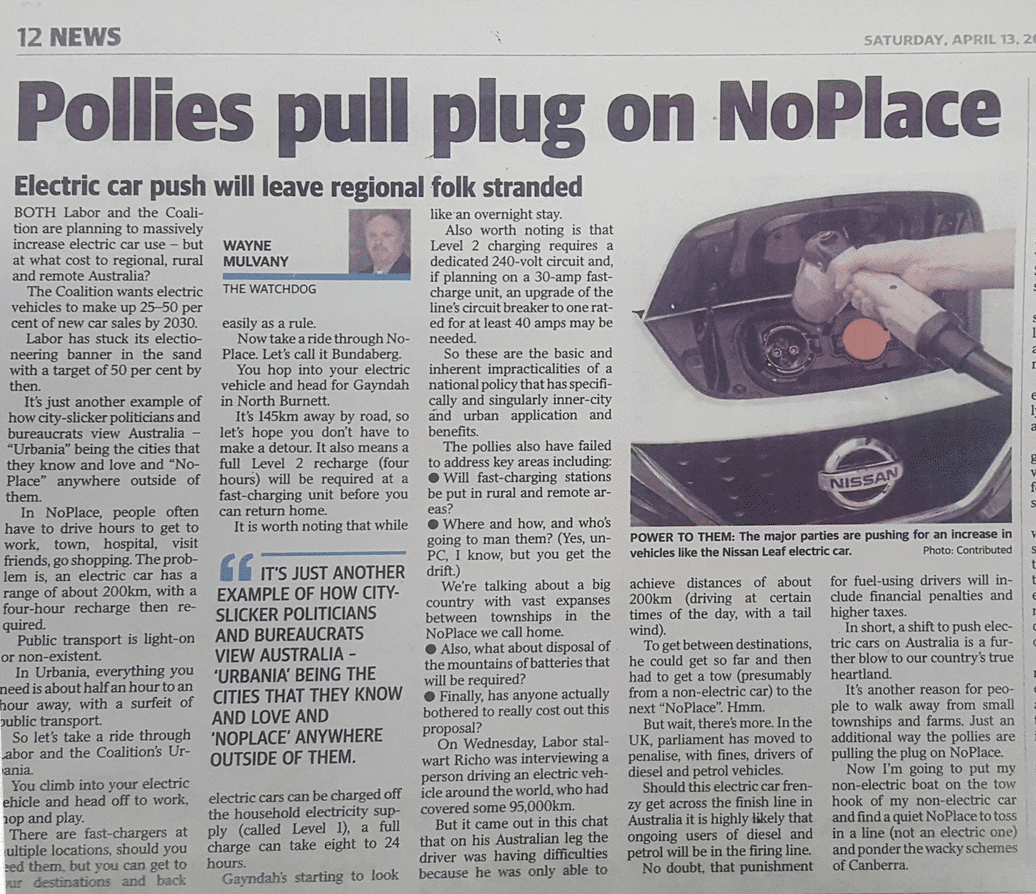Pollies pulling the plug on ‘NoPlace’

BOTH Labor and the Coalition are planning to massively increase electric car use – but at what cost to regional, rural and remote Australia?
The Coalition wants electric vehicles to make up between 25% and 50% of all new car sales by 2030. Labor has stuck its electioneering banner in the sand with a target of 50% by then.
It’s just another example of how city slicker politicians and bureaucrats view Australia – “Urbania” being the cities that they know and love, and “NoPlace” anywhere outside of them.
In NoPlace, people often have to drive hours to get to work, town, hospital, visit friends, go shopping. The problem is, an electric car has a range of around 200km, with a four-hour recharge then required. Public transport is light on, or non-existent.
In Urbania, everything you need is around half an hour to an hour away, with a surfeit of public transport.
So let’s take a ride through Labor and the Coalition’s Urbania …
You climb into your electric vehicle and head off to work / shop / play. There are fast-chargers at multiple locations, should you need them, but you can get to your destinations and back easily as a rule.
Now take a ride through NoPlace. Let’s call it Bundaberg. You hop into your electric vehicle and head for Gayndah in North Burnett. It’s 145km away by road, so let’s hope you don’t have to make a detour. It also means a full Level 2 recharge (four hours) will be required at a fast-charging unit before you can return home.
It is worth noting that while electric cars can be charged off the household electricity supply (called Level 1), a full charge can take eight to 24 hours. Gayndah’s starting to look like an overnight stay.
Also worth noting is that Level 2 charging requires a dedicated 240-volt circuit and, if planning on a 30-amp fast-charge unit, an upgrade of the line’s circuit breaker to one rated for at least 40 amps may be needed.
So these are the basic and inherent impracticalities of a national policy that has specifically and singularly inner-city / urban application and benefits.
The pollies also have failed to address key areas including: will the electric car tow a boat / trailer? I understand it won’t. Will fast-charging stations be put in the rural /remote areas? Where and how, and who’s going to man them (yes, un PC I know, but you get the drift)? We’re talking about a Big Country with vast expanses between townships in the NoPlace we call home.
Also, what about disposal of the mountains of batteries (hazardous waste) that will be required. Finally, has anyone actually bothered to really cost out this proposal?
On Wednesday, Labor stalwart “Richo” was interviewing a person driving an electric vehicle around the world who has covered some 95,000 km. But it came out in this chat that on his Australian leg the driver was having difficulties because he was only able to achieve distances of some 200km (driving at certain times of the day, with a tail wind). To get between destinations, he could get so far and then had to get a tow (presumably from a non-electric car) to the next “NoPlace”. Hmm.
But wait, there’s more. In the UK, parliament has moved to penalise, with fines, drivers of diesel / petrol vehicles. Should this electric car frenzy get across the finish line in Australia it is highly likely that ongoing users of diesel and petrol will be in the firing line. No doubt, that punishment for fuel-using drivers will include financial penalties / higher taxes.
In short, a shift to push electric cars on Australia, and across our nation, is a further blow to our country’s true heartland. It’s another reason for people to walk away from small townships and farms. Just an additional way the pollies are pulling the plug on NoPlace.
Now I’m going to put my non-electric boat on the tow hook of my non-electric car and find a quiet NoPlace to toss in a line (not an electric power line) and ponder the wacky schemes of Canberra.